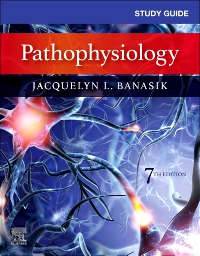
Study Guide for Pathophysiology, 7th Edition
Paperback

Now $35.69
Binder-Ready Edition: This loose-leaf copy of the full text is a convenient, accessible, and customizable alternative to the bound book. With this binder-ready edition, students can personalize the text to match their unique needs!
The ultimate study tool to help you master pathophysiology! Corresponding to the chapters in Banasik’s Pathophysiology, 7th Edition textbook, this study guide helps you review and practice the material with a variety of exercises and question types, including multiple choice, true/false, matching, fill in the blank, compare/contrast, and labeling. Thorough updates include nearly 50 case studies that provide real-life examples to help you develop the clinical judgment and critical thinking skills you need for career success.
-
- More than 1,500 questions enable you to have in-depth review and practice sessions with engaging questions in a variety of formats, including labeling, multiple choice, true/false, fill in the blank, compare/contrast, and matching.
- Multiple case studies at the end of each unit, totaling almost 50 case studies in all, feature questions to help you practice applying key concepts and develop your clinical reasoning and judgment.
- Answer key is conveniently located in the back of the study guide.
-
- Thoroughly updated content matches the 7th edition of the textbook.
-
Unit I: Pathophysiologic Processes
1. Introduction to Pathophysiology
2. Homeostasis and Adaptive Responses to Stressors
Unit II: Cellular Function
3. Cell Structure and Function
4. Cell Injury, Aging, and Death
5. Genome Structure, Regulation, and Tissue Differentiation
6. Genetic and Developmental Disorders
7. Neoplasia
Unit III: Defense
8. Infectious Processes
9. Inflammation and Immunity
10. Alterations in Immune Function
11. Malignant Disorders of White Blood Cells
12. HIV Disease and AIDS
Unit IV: Oxygen Transport, Blood Coagulation, Blood Flow, and Blood Pressure
13. Alterations in Oxygen Transport
14. Alterations in Homeostasis and Blood Coagulation
15. Alterations in Blood Flow
16. Alterations in Blood Pressure
Unit V: Cardiac Function
17. Cardiac Function
18. Alterations in Cardiac Function
19. Heart Failure and Dysrhythmias: Common Sequelae of Cardiac Diseases
20. Shock
Unit VI: Respiratory Function
21. Respiratory Function and Alterations in Gas Exchange
22. Obstructive Pulmonary Disorders
23. Restrictive Pulmonary Disorders
Unit VII: Fluid, Electrolyte, and Acid-Base Homeostasis
24. Fluid and Electrolyte Homeostasis and Imbalances
25. Acid-Base Homeostasis and Imbalances
Unit VIII: Renal and Bladder Function
26. Renal Function
27. Intrarenal Disorders
28. Acute Kidney Injury and Chronic Kidney Disease
29. Disorders of the Lower Urinary Tract
Unit IX: Genital and Reproductive Function
30. Male Genital and Reproductive Function
31. Alterations in Male Genital and Reproductive Function
32. Female Genital and Reproductive Function
33. Alterations in Female Genital and Reproductive Function
34. Sexually Transmitted Infections
Unit X: Gastrointestinal Function
35. Gastrointestinal Function
36. Gastrointestinal Disorders
37. Alterations in Function of the Gallbladder and Exocrine Pancreas
38. Liver Diseases
Unit XI: Endocrine Function, Metabolism, and Nutrition
39. Endocrine Physiology and Mechanisms of Hypothalamic-Pituitary Regulation
40. Disorders of Endocrine Function
41. Diabetes Mellitus
42. Alterations in Metabolism and Nutrition
Unit XII: Neural Function
43. Structure and Function of the Nervous System
44. Acute Disorders of Brain Function
45. Chronic Disorders of Neurologic Function
46. Alterations in Special Sensory Function
47. Pain
Unit XIII: Neuropsychological Function
48. Neurobiology of Psychotic Illnesses
49. Neurobiology of Nonpsychotic Illnesses
Unit XIV: Musculoskeletal Support and Movement
50. Structure and Function of the Musculoskeletal System
51. Alterations in Musculoskeletal Function: Trauma, Infection, and Disease
52. Alterations in Musculoskeletal Function: Rheumatic Disorders




 as described in our
as described in our 